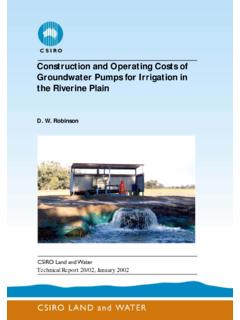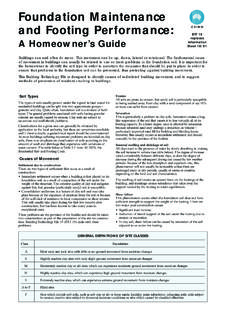Transcription of Making Better Fertiliser Decisions for Grazed Pastures in ...
1 An interpretation of soil tests and a method for assessing nutrient loss for Grazed Pastures in Australia Making Better Fertiliser Decisions for Grazed Pastures in AustraliaMaking Better Fertiliser Decisions for Grazed Pastures in AustraliaPublished by the Victorian Government Department of Primary Industries The State of Victoria, Department of Primary Industries, June publication is copyright. No part may be reproduced by any process except in accordance with the provisions of the Copyright Act by the Victorian Government1 Spring St, Melbourne, Victoria 3000 AustraliaPrinted by Drouin Commercial PrintersISBN 978-1-74199-208-3 (hardcopy)ISBN 978-1-74199-143-7 (online)
2 DisclaimerThis publication may be of assistance to you but the State of Victoria and its employees do not guarantee that the publication is without flaw of any kind or is wholly appropriate for your particular purposes and therefore disclaims all liability for any error, loss or other consequence which may arise from you relying on any information in this Grazed Pastures in AustraliaMaking BetterFertiliser DecisionsAuthorsCameron J P GourleyAlice R MellandRaquel A Waller Ivor M AwtyAndrew P SmithKen I PeverillMurray C HannahFor more information contact:Dr Cameron GourleyDepartment of Primary Industries Victoria1301 Hazeldean RoadEllinbank Vic 3821 Phone: 03 5624 2222 Email: PrefaceFertiliser continues to be a key input for most of Australia s pasture-based grazing enterprises, with its strong influence on pasture production and profitability.
3 However, excessive Fertiliser use or inappropriate application practices can lead to significant nutrient pollution of land, water and air. Producers and their advisors need the best possible information and tools to support Better Fertiliser decision- Making if they are to satisfy the dual goals of profitability and environmental Better Fertiliser Decisions project (BFD) (2003-2007) was conducted to provide comprehensive information to improve Fertiliser Decisions for grazing industries. National in scope, the BFD project compiled and interpreted results from pasture- Fertiliser experiments and information on nutrient loss processes from all pasture-based grazing regions (Figure 1).
4 To this end, the BFD project has delivered: Soil test pasture response relationships and critical soil test values for phosphorus (P), potassium (K) and sulfur (S) differentiated at regional, state and national scales, and also by soil characteristics such as soil texture and P buffering index (PBI); An interactive database containing all the data submitted on pasture responses to applied nitrogen (N), P, K and S Fertiliser ; The Farm Nutrient Loss Index (FNLI), a decision support tool to assess the risk of nutrient loss from the paddock to the off-farm environment in the format of a user-friendly computer program.
5 The response relationships are based on a large amount of data collated from an extensive national review of soil test pasture response experiments conducted over the past 50 years. Sources of this information included peer-reviewed scientific publications, government and industry reports, as well as unpublished data. All experimental data used in the development of the response relationships were standardised and met rigorous quality assurance criteria. 2182021221719242325261614151371081291127 2928306543211 South2 Midlands and East Coast3 North East4 North5 NorthWest6 FarNorthWest7 East Gippsland8 NorthEast9 WestGippsland10 NorthCentral11 Wimmera12 SouthWest13 South East14 KangarooIsland15 LowerMurray16 AdelaideHillsTasmaniaVictoriaSouth AustraliaNew South WalesQueenslandWestern Australia17 SouthCoastal18 Central and SouthernTablelands19 Southern Slopesand Plains20 NorthCoastal21 Northern Tablelands22 Northern Slopesand Plains23 DarlingDowns andBurnett24 CoastalSouth East25 DrySub-tropics26 Wet TropicalCoast27 SouthCoast28 GreatSouthern29 SouthWest30
6 WestMidlandsThe database serves as a comprehensive resource for information about previous pasture- Fertiliser response experiments and provides the capacity to accommodate new data in the future. The FNLI was developed by collating regionally specific information on nutrient loss processes from scientific publications and existing data, with input from over 90 nutrient management researchers, extension experts and Fertiliser company staff. The FNLI uses easily quantifiable inputs such as landscape features, climatic conditions, and pasture and stock management practices to calculate the risk of N and P loss at the paddock scale and evaluate the effects of different management booklet presents soil test pasture response relationships and interpretations for the major P, K and S soil tests used in Australia and a description of the FNLI.
7 The FNLI tool and associated User Manual are included on the accompanying CD. The booklet and information is endorsed by the Fertilizer Industry Federation of Australia, major Fertiliser companies in Australia, and Fertcare , a national accreditation initiative by the Australian Fertiliser and East Coast3 North East4 North5 NorthWest6 FarNorthWest7 East Gippsland8 NorthEast9 WestGippsland10 NorthCentral11 Wimmera12 SouthWest13 South East14 KangarooIsland15 LowerMurray16 AdelaideHillsTasmaniaVictoriaSouth AustraliaNew South WalesQueenslandWestern Australia17 SouthCoastal18 Central and SouthernTablelands19 Southern Slopesand Plains20 NorthCoastal21 Northern Tablelands22 Northern Slopesand Plains23 DarlingDowns andBurnett24 CoastalSouth East25 DrySub-tropics26 Wet TropicalCoast27 SouthCoast28 GreatSouthern29 SouthWest30
8 WestMidlandsPasture-based grazing regions of Australia, defined by climate, pasture type and soil test pasture response relationships and FNLI are available via the Commonwealth Scientific and Industrial Research Organisation s (CSIRO) Australian Soil Resource Information System (ASRIS) internet site: Soil test valuePercentage of maximum pasture yield95100 Pasture growth notlimited by deficiencyPasture growthlimited by deficiency0A generalised calibration relationship between relative pasture production and soil test value. Figure test pasture response relationshipsSoil test pasture response calibrations define the relationship between pasture production and soil test value (Figure 2).
9 The relationship allows users to predict the pasture production response if the soil nutrient level is altered by the addition of from the pasture-based grazing industries of Australia provided experimental results to develop the newly defined pasture response relationships. Over 3,000 experimental years of research results were compiled, some dating back 50 years, including in excess of 250 experiments involving approximately 1,600 field sites, and more than 48,000 individual pasture yield had to meet certain design, data collection and quality criteria to be included in the analysis. This included a zero application (control) and high application treatment of P, K or S.
10 Only experiments that used the following Australian soil tests: Olsen and Colwell P; Colwell, Skene and exchangeable K; and CPC and KCl-40 S, were analysed, as there were insufficient data to analyse less commonly used tests. It was not possible to develop soil test pasture response relationships for N as there is no reliable soil test for N. Soil test sample depth was standardised to 10 test pasture response relationships were prepared, where possible, for P, K and S, nationally and differentiated by state, region, soil texture, PBI and cation exchange capacity categories. The lack of quality data regarding pasture species, pasture composition, and grazing enterprise meant that soil test pasture response relationships could not be differentiated by these factors.






